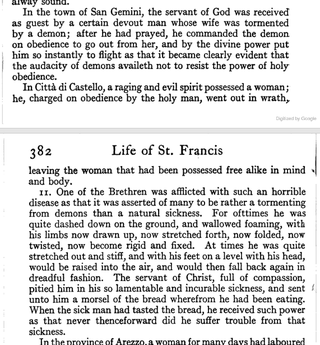
Neuroscience
The Power of Neuroscience Compels You
It's not the devil, it's the brain.
Posted August 15, 2018 Reviewed by Jessica Schrader
Last February, the Vatican announced that it was offering an exorcism training course* for priests. At first I thought it was a great way to celebrate the 45th anniversary of the release of the horror classic The Exorcist, but as it turned out, this initiative was in response to an alarming rise in the number of demonic possessions around the world—that is, according to the Catholic Church.
Exorcisms are rituals that have been performed since biblical times to expel evil spirits from people or places. The first official guidelines for performing exorcisms in the Catholic Church were laid out back in 1614, with the catchy name De exorcismis et supplicationibus quibusdam, meaning Of Exorcisms and Certain Supplications. Religions like Judaism and Islam, among others, also have exorcisms, and still carry on this practice today.
I’m sure that in 1614 the ways of the Catholic Church were more popular than neuroscience, and it is possible that the only and best explanation for erratic behaviors, altered personalities, erased memories, seizures, and fainting was possession by some ancestral evil spirit, rather than a neurological disorder.
Now, despite the fact that the Vatican still believes that demonic possessions are a thing—and that in fact they have seen an exponential rise in cases worldwide—science can better explain these apparently supernatural occurrences. Most likely, solving these cases are work for neuroscientists and physicians rather than exorcists.
Neurological Disorders, Not Demons
In 2012, Brain on Fire was published. It is an autobiographical story of the hellish experience that Susannah Cahalan endured. Netflix released a film based on the book in 2016. (SPOILER ALERT: If you haven’t read or seen Brain on Fire and don’t want it ruined for you, skip to the next section.)
Susannah was suffering from a rare autoimmune disease called anti-NMDAR encephalitis that has been traditionally mistaken for demonic possession. Nobody thought Susannah was possessed by demons, but reading her description or seeing some of the scenes from the movie, it is easy to imagine that she would be an ideal candidate for exorcism. The symptoms of this autoimmune disease develop fast and range from seemingly innocuous flu-like symptoms to major problems like seizures, memory loss, disturbing behavior, and abnormal movements. It is mostly women who have been diagnosed with this disease, usually aged between 18 and 45, and often ovarian tumors—in particular, teratomas—were the cause of the autoimmune reaction. However, not all patients were as lucky as Susannah: Many ended up in psychiatric wards, or were believed to be possessed by the devil.
Rituals of exorcism, far from fixing the underlying neurological disorder, may worsen the symptoms in the long run due to the clash between religion and medicine, preventing patients from receiving the proper diagnosis and treatments.
From Biblical Times to the 20th Century
There are many cases described in the pages of the Bible that are presented as demonic possessions but were most likely patients suffering from different neurological disorders such as schizophrenia or even depression. In the New Testament, Mark 5:1-20 describes a man with an impure spirit came from the tombs to meet [Jesus] and who would cry out and cut himself with stones. If that man was suffering from previous depression and/or schizophrenia, abandoning him in an inhospitable outdoor area, as was the case, would not have improved his mental health. Patients with neurological disorders during biblical times were not acknowledged, let alone given the care they needed.
Another example is presented in the book Life of Saint Francis, which tells the story of St. Francis of Assisi. This book explains at least three exorcisms, and offers details about the symptoms of the allegedly possessed person in at least one of them.

Fainting, foaming from the mouth, and seizures are symptoms characteristic of an epileptic episode, specifically a tonic clonic seizure. In this story they claim that bread delivered from the saint was enough to “cure” him, and in the other two cases, the women were “healed” through St. Francis’ commands and prayers. Most likely, the epileptic fits were just over.
Except for status epilepticus, which constitutes seizures that last longer than five minutes or consecutive seizures without recovery time in between, epileptic episodes just stop naturally. This would have been interpreted as the evil spirit leaving the body of the possessed, if the exorcism was timely.
A more recent and better-documented case is that of a 28-year-old woman who suffered from paranoid schizophrenia. She was diagnosed, treated with limited success, and turned to exorcisms to try to alleviate her symptoms. She was interested in esotericism, and exorcism rituals nurtured her obsession, decreasing her motivation to seek appropriate medical treatment.
Exorcisms may actually result in emotional, psychological, and occasionally physical abuse to the patient. Tajima-Pozo and collaborators highlight the importance of discussions between clerics, neurologists, and psychiatrists for the sake of the patient. Even today, the priest’s opinion can be louder and more convincing than facts and scientific evidence for those patients devoted to religion.
Another example of this was the real case on which the film The Exorcism of Emily Rose is loosely based. Anneliese Michel was an extremely devout 23-year-old who suffered from epilepsy and severe depression, but was convinced that she was possessed. The priests, and her own parents, had a heavy influence on her decisions, and prevented her from seeking medical help. After more than 60 exorcisms, they let her starve to death as she thought that would make the demons go away.
Patients with Tourette’s syndrome have also been the target for alleged demonic possessions. The symptoms of a person with Tourette’s syndrome include involuntary movements, muscle spasms, uncontrollable word repetition and swearing, and lack of restraint, among others. The ideal combination for the exorcism aficionado.
Science Versus Religion
Science and religion have been considered to be at opposite poles for centuries. One would think that a patient’s beliefs shouldn’t get in the way of a proper diagnosis. However, nurturing the obsessions (or beliefs) of a patient with a neurological or psychiatric disorder may drive them further away from reality, resulting in fatal consequences. Encouraging someone to get an exorcism may lead them to refuse medical treatment. In De exorcismis et supplicationibus quibusdam, the priests are urged to discern between demonic possession and mental illness (or melancholy, a term that was used back in the 17th century to refer to neurological disorders). The only problem is that exorcists are not trained to recognize mental illness but possessions.
But do demonic possessions exist? Statistically speaking, it is more likely that a mental issue is at fault, rather than Lucifer taking over a soul.
*The Vatican training course for exorcists was held April 16-21 of 2018. Sorry, you missed it.
This post was also published in NeuWriteSD.
References
Kayser MS, Dalmau J. Anti-NMDA Receptor Encephalitis in Psychiatry. Current psychiatry reviews. 2011;7(3):189-193. doi:10.2174/157340011797183184.
“The Little Flowers” & the Life of St. Francis with the “Mirror of Perfection.” edited by Thomas Okey.
Tajima-Pozo K, Zambrano-Enriquez D, de Anta L, et al. Practicing exorcism in schizophrenia. BMJ Case Reports. 2011;2011:bcr1020092350. doi:10.1136/bcr.10.2009.2350.



